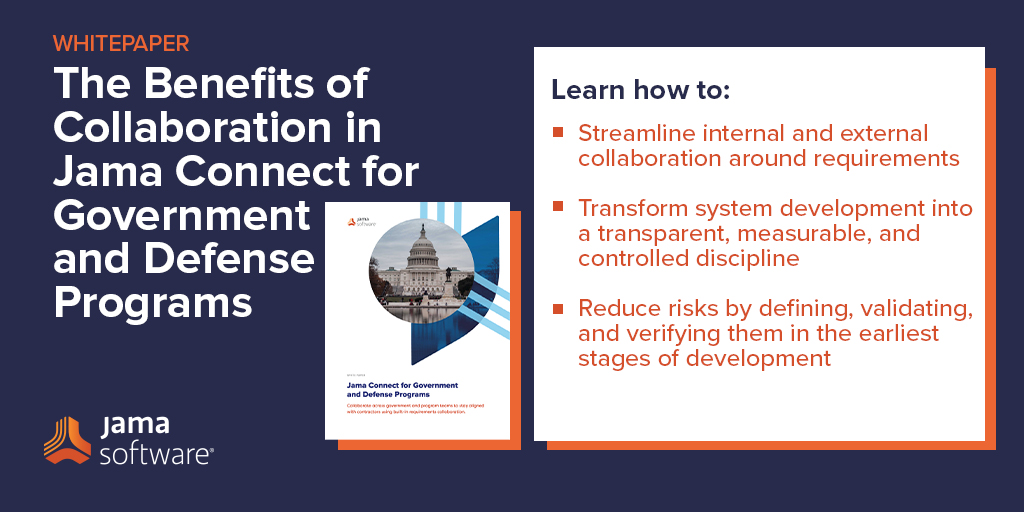The Benefits of Collaboration for Government and Defense Teams
Tomorrow’s defense and government systems must be built at a lower cost with shorter timelines often using new Agile acquisition strategies. Since government and defense program teams are largely comprised of civilians and contractors working in distributed locations, efficient and streamlined collaboration is crucial.
In 2018 the US Secretary of Defense encouraged everyone to adopt new practices in order to modernize delivered systems and prioritize the speed of delivery. This encouragement was backed by a Digital Engineering Strategy with aims to allow the DoD and industry partners to work more collaborative at the engineering level. They defined digital engineering “as an integrated digital approach that uses authoritative sources of system data and models as a continuum across disciplines to support lifecycle activities from concept through disposal.”
Expected benefits of digital engineering include:
- Better informed decision making
- Enhanced communication
- Increased understand of and confidence in the system design
- A more efficient engineering process
Jama Connect’s digital mission engineering platform has been specifically designed to assist in reaping these benefits. The platform’s core functionalities – including requirements version control, change management, baseline management, traceability, verification and validation, and risk analysis – are enhanced with a streamlined collaboration capability that establishes alignment across teams working within complex government programs.
Jama Connect lets government programs leverage lean, information-driven lifecycle techniques for managing strategic objectives, requirements, Agile user stories, features, risks and more.
Two qualities that set Jama Connect apart from the competition include:
- Ease of use without lengthy training
- Ease of adoption by broader types of user roles
RELATED: How to Realign Engineering Teams for Remote Work with Minimal Disruption
Aligning Distributed Government and Defense Teams
Distributed government and defense teams must consider ease of adoption and usability when researching requirements management (RM) solutions. Our customers confirm that if engineers and stakeholders don’t find a system intuitive and accessible, acquisition and implementation can be a costly miscalculation. Jama Connect is built and maintained with high-fidelity usability as the guiding principle.
Many requirements management tools require users to achieve unrealistic levels of expertise or otherwise hire expensive experts who fit the criteria. Consequently, most teams end up working outside the system using documents and spreadsheets. The result: A requirements and traceability ordeal that slows the development cycle, introduces unnecessary amounts of risk, and defeats the purpose of having a dedicated RM tool.
RELATED: A Path to MBSE with Jama Connect
The Benefits of Collaboration in a Modern Requirements Management Platform
Requirements management in Jama Connect eliminates reliance on documents and supports rapid delivery of complex, workable systems by bridging all the teams and work in real-time. The result is the connection of a multitude of interacting subsystems with a robust digital thread.
Jama Connect provides a modern solution that transforms system development into a transparent, measurable, and controlled systems engineering discipline. With industry-leading competence in an enterprise-class platform that is rapidly adaptable to the unique needs of each organization, Jama Connect is an analyst-recognized leader in the requirements management market, delivering unmatched value in each of the following areas:
- Requirements Engineering: Our web-based application provides the ability to intuitively author requirements, maintain versions, control change, baseline, and collaboratively review and approve.
- End-to-End Traceability: Link and decompose program-level capability requirements and operational requirements to derived system requirements, and then down to lower-level software and hardware requirements.
- Change Management: With fine-grain impact analysis providing instant data insights, you can make informed decisions as requirements evolve during long development cycles or shift in mission, cost, or technology.
- Fast Reviews & Approvals: Share and gain consensus on acceptance criteria by leveraging higher levels of stakeholder collaboration among government, suppliers, and subcontractors.
- Virtualized Control Boards: Built-in collaboration technology lets teams capture all communication in a central system alongside system data. Items linked to related conversations, questions, and reasoning can be reviewed throughout development and archived after.
- Quicker, Clearer Decisions: Request decisions on changes within the context of the items and projects. Transparent decision-making gives you immediate clarity and saves time.
- Risk Management: The pressure to develop systems with lower costs, shorter timelines, and agile acquisition never stops. Jama Connect provides a voice across acquisition, development, and integration teams to collaboratively define, validate, and verify risks and ensure that they are accounted for and mitigated in the earliest stages of development.
- Verification & Validation: Seamlessly manage traceability between requirements and test cases used for verification & validation and provide evidence to comply with regulations and standards.



